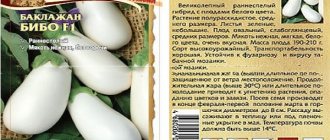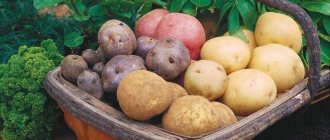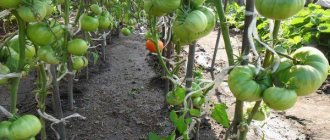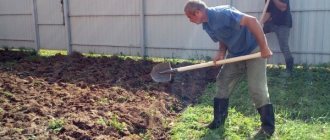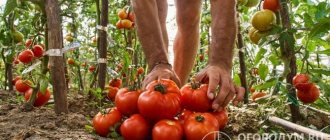Description of the variety
Roko is an achievement of Dutch selection. Potatoes of this variety appeared in Russia in 2002. It is grown both on an industrial scale and in summer cottages.
Difference from other varieties
Roko differs from other varieties in appearance. It is characterized by medium-tall, erect bushes with an abundance of shoots. The flowers are purple, the leaves are small with wavy edges. Often there is no flowering.
Another difference between Roko potatoes and other varieties is their high starch content (up to 16%) and unique taste, thanks to which they are loved by housewives all over the world. The tubers are boiled, fried, baked, and used to make chips and French fries.
Reference . During the cooking process, potatoes do not tend to boil, lose shape or change color. The pulp remains white after heat treatment.
Comparison table between Rocco and other potato varieties.
| Name | Starchy content, % | Weight of potatoes, g | Yield indicator, c/ha |
| Rocko | 13-16 | 125 | 400 |
| cornflower | 12-15 | 80-120 | 200-400 |
| Sineglazka | 15 | 70-130 | 500 |
| Breeze | 11-14 | 100-150 | 600 |
| Kubanka | 10-14 | 90-130 | 220 |
| Alvara | 12-14 | 90-100 | 300-440 |
Chemical composition, trace elements and vitamins
Roko is characterized by a rich chemical composition, due to which its consumption is beneficial for health.
Tubers contain a lot of:
- nicotinic acid;
- beta-carotene;
- retinol;
- thiamine;
- riboflavin;
- pantothenic acid;
- pyridoxine;
- folic acid;
- ascorbic acid;
- tocopherol;
- biotin.
Tubers are rich in beneficial microelements. They contain calcium, magnesium, sodium, potassium, phosphorus, sulfur, iron, zinc, selenium, manganese, iodine, copper, fluorine. The composition contains a number of organic and saturated fatty acids, as well as mono- and disaccharides.
The calorie content of 100 g of potatoes is 77 kcal. In addition to water, this amount of product contains:
- proteins – 2 g;
- fat – 0.4 g;
- carbohydrates – 16.3 g;
- dietary fiber – 1.4 g.
Characteristics of tubers and yield
The Roko variety is a high-yielding variety. From one bush you get up to 12 tubers weighing about 125 g each. The yield indicator is 40 t/ha.
Potatoes have an oval shape. Their surface is smooth. The tubers are covered with a thin peel, ranging in color from light pink (or pale purple) to brown. The pulp is light with a creamy tint, tender.
Potatoes are distinguished by high quality and a marketability rate of 95%.
Regions for cultivation and planting dates
Roko is a variety with a medium ripening period. It takes 90-100 years from planting to harvest. Under unfavorable climatic conditions, the ripening period is longer - up to 150 days. That's why it is sometimes called late.
Potatoes of this variety grow in any weather, including drought and prolonged rainfall. Roko is suitable for growing in any region of the Russian Federation. It is unpretentious, not picky about soil and growing conditions.
Planting is recommended in May, when the soil warms up to +10⁰С. Roko is dropped off:
- in the first days - in the southern regions;
- in the middle of the month - in the central regions;
- at the end of May - in the northern part of the country.
Characteristic
The root vegetable is one of the most sought after vegetables as it acts as the main ingredient in most dishes. But the popularity of potatoes is due not only to their unique taste, but also to the presence of a huge amount of useful micro- and macroelements in the composition. Any gardener, when selecting a variety to grow on his plot, takes into account reviews of the crop, gets acquainted with the characteristics, ripening time and yield. All of the above qualities deserve the highest rating from Rocco potatoes.
This root vegetable is rightfully considered the best vegetable hybrid; it was obtained as a result of the work of Dutch breeding scientists. Today it is widespread throughout the world; cultivation of the crop is quite successful in the Netherlands, France, India and other countries. In addition, the variety produces excellent harvests in Ukraine, Kazakhstan and Belarus. Domestic summer residents and gardeners have been cultivating the hybrid for more than 15 years; it was the popularity of the crop that served as the impetus for getting to know the foreign potato variety, due to which it is grown on a large scale on Russian farms.
Rocco tubers are recommended for home cooking, as well as for the production of foods that include potatoes, such as chips or other snacks. After cooking, the variety is distinguished by crumbly pulp, and the fried vegetable acquires an appetizing golden crust. It is worth noting that the name of the hybrid “Rocco” is common among gardeners, but this is not an entirely correct name for the crop, since it was listed in the State Register as “Rocco”.
Even if you are unfamiliar with the description of the tuber variety, it is quite easy to distinguish it from other vegetables due to its appearance. The root crop grows on small, upright bushes, the height of which, as a rule, does not exceed half a meter. The foliage is medium-sized with wavy edges. The plant blooms with lilac inflorescences in minimal quantities; there are bushes that have no flowers at all, which in no way affects the formation of ovaries.
Potatoes grow oval, slightly elongated, and the weight of one tuber is about 125 grams. The peel is red-violet, smooth, with a minimum number of eyes. The flesh is creamy and very tender. The starch content in tubers of this variety is at the level of 16%.
The timing of crop ripening varies depending on the climatic conditions in which it grows. Therefore, in some regions, “Rocco” is classified as a medium-ripening variety, and in others – late. As a rule, the growing season of a hybrid varies between 70-150 days. You can determine the readiness of the root crop for harvesting by the state of the plant - the tops turn yellow and then disappear completely. On average, one nest forms from ten to twelve tubers.
Potatoes are distinguished by their good transportability, and if the correct room temperature is maintained, the crop will be suitable for consumption for about six months from the date of harvest. It is noteworthy that tubers do not germinate in cool conditions, do not rot, and retain their taste at the same level. The yield of root crops, even in the most difficult weather conditions, is about 400 centners per hectare of land.
Advantages and disadvantages
The Roko potato variety has many advantages, including:
- high productivity;
- marketable condition;
- excellent taste;
- immunity to virus Y, cancer, golden nematode;
- drought resistance;
- ease of care;
- good indicator of shelf life (in favorable conditions, tubers are stored for a long time without changing their appearance and taste characteristics).
The variety has virtually no disadvantages. One of the few is the susceptibility of plants to leaf blight.
Taste qualities
According to the characteristics of Rocco potatoes, the tubers of the variety have excellent taste:
- the color of the pulp is preserved after heat treatment;
- a good variety for making French fries or homemade chips;
- The starch content reaches, depending on growing conditions, 13-16%.
Potatoes have many positive characteristics, thanks to which they have become popular all over the world. The main thing is to properly care for the bush and give it enough sunlight, and then you will be able to notice how correct your choice was.
- Large percentage of bush yield. In addition, the yield of a species is a stable concept. It is rare that one year there are many fruits, but the next year there are few. Even when there are bad years, you can collect more than 350 centners of fruit. And when all the signs converge, and the year is fruitful, then from 1 hectare, about 600 centners.
- Potato Rocco (variety description): 12-14 tubers can form on one bush alone. Only one tuber weighs 130 grams, because of this we can conclude that one bush can give you 2 kg of fruit.
- All fruits have a good presentation, can be stored for a long time and tolerate transportation well. Of 100% of all goods received, 95% retain their appearance.
- And as mentioned earlier, the product can withstand long-term transportation. This variety can be found in every store and market. If you store potatoes in a cold place, they can be stored for up to 5 months.
- Rocco potatoes are classified as a table type of potato. It has excellent taste; the total percentage of starch can range from 11 to 16%. When cooked, the pulp does not change its color.
- This variety is perfect for everything: frying, pies, mashed potatoes, French fries, etc.
The main thing to remember is that you cannot eat the flowers and stems of the plant. Such components of the bush can cause severe food poisoning in humans.
Features of planting and growing
Roko is distinguished by its unpretentiousness in cultivation, carried out according to the rules of agricultural technology of this vegetable crop. Plants are content with minimal care.
Preparation
Vegetable crops of this variety are grown in a clean area. Roko does not grow in soil with a predominance of weeds. Weeds inhibit the tubers and prevent them from developing.
The soil for planting should be light, nutritious, and loosened. Poor soil is enriched with fertilizers; wood ash or humus is added to heavy soil.
Planting material is selected carefully: tubers without spots, growths, or signs of damage by insects are needed. They are germinated in a well-lit room. Tubers with sprouts no more than 1 cm in length are suitable for planting.
Planting scheme and technology
When planting planting material in open ground, adhere to the standard scheme. A distance of 35 cm is maintained between holes, and 60-70 cm between rows. The depth of the holes should not exceed 10 cm.
Features of cultivation
To obtain the highest possible yield, it is recommended to grow potatoes in floodplain, sod-podzolic, light loamy, sandy loam soil with a neutral acidity index.
It is advisable to grow potatoes in a well-lit and ventilated area. The plants are sun-loving, so they grow more slowly in the shade.
Nuances of care
Caring for plants primarily involves proper hilling. Thanks to it, you can increase productivity by 30%. Hilling helps saturate the soil with oxygen and get rid of weeds. Roko is spud twice:
- when the plants reach a height of 20 cm;
- on the eve of the flowering period.
Plants need loosening several times during the season. The soil is loosened between the rows after watering.
Another important procedure in caring for potato plantings is weeding. Without it you cannot get a good harvest . Weed the bushes using a hoe twice:
- 1 month after planting in open ground when the sprouts reach a height of 3-4 cm;
- when the bushes reach a height of 25-30 cm.
It is permissible to carry out weeding using a cultivator or walk-behind tractor.
Watering mode
Roko is drought tolerant, but needs proper watering. Water the plants three times during the season:
- when the tops appear;
- on the eve of flowering;
- before the flowers disappear.
Watering is carried out in the morning or evening hours in the absence of scorching sunlight. The first time the bush is watered with 2 liters of water, the second and third times they take 2 times more liquid. Water is first poured into barrels so that it can settle and warm up in the sun.
Important ! Watering is contraindicated before sprouts form and immediately after flowering. There is a risk of late blight.
Watering is carried out in one of the following ways:
- Sprinkling - finely drip irrigation of the planting with water from a hose.
- Superficial. Suitable if groundwater is no higher than 4 cm.
- Drip irrigation. Watering is carried out through irrigation tubes connected to the roots of the plants.
Top dressing
To obtain maximum yield, fertilizers are needed. They are applied in the fall when digging after harvesting and clearing the area of weeds.
Apply fertilizer in the form of:
- an aqueous solution of bird droppings (1:10), which is used to water the soil between the rows;
- urea solution (1 tbsp per 10 liters of water) for watering bushes;
- mullein, which is used to water the rows.
Disease and pest control
Compliance with the rules of agricultural technology allows you to avoid scab damage.
However, Roko is susceptible to late blight. It attacks leaves in cold, rainy weather. Preventive treatment with fungicides ("Revus Top", "Ordan", "Poliram") or antifungal agents ("Maxim", "Fundazol") allows you to avoid the problem.
Treatment with Bazudin helps protect plants from wireworms. The Colorado potato beetle is collected from the bushes by hand.
Difficulties encountered during cultivation
Growing Roko potatoes does not pose any great difficulties. You get a bad harvest if you don’t adhere to the basic rules of agricultural technology. Typical mistakes:
- Use of organic matter in unreasonable periods. This mistake entails the leaching of nutrients and, as a result, a meager harvest.
- Using unrotted manure in the spring. Leads to the accumulation of weeds and pathogens of various plant diseases.
- Violation of the water regime. Leads to incomplete absorption of mineral fertilizers from the soil by the crop.
Potato care
Caring for the Rocco potato variety consists of regular weeding, watering and spraying the plant against pests.
- Particular attention should be paid to loosening the soil, since this technique ensures normal “breathing” for root crops. Weeding is also necessary for the timely removal of weeds, which suck nutrients from the plant.
- Watering should be done as needed, only during drought or when the soil dries out excessively. In order not to erode the roots of the plant and reduce the amount of moisture, it is better to mulch the soil in the beds with potatoes. Some summer residents hill up bushes with potatoes when they reach 14-16 cm in height, and after 7-8 days they repeat this technique.
- To protect seedlings, you don’t need to wait until they are attacked by insects. Potato bushes should be treated with fungicides and insecticides for the purpose of prevention.
- During the growing season, the plant needs feeding. Potatoes are fertilized with organic fertilizers, saltpeter, mineral complexes with a high content of phosphorus and potassium and, as already mentioned, wood ash.
Harvest and storage
A good crop shelf life is ensured by compliance with the rules of collection and storage.
How and when to collect
The harvest is collected in a timely manner. Otherwise, there is a risk that the tubers will begin to deteriorate and rot. The timing of digging up potatoes is determined by the condition of the tops. It should turn yellow and dry out. A test dig is recommended to determine the degree of maturity of the potatoes.
Reference . After the tops die, the potatoes must be dug up before the rains. The optimal time for harvesting is from late August to mid-September.
On the eve of digging up the tubers, the tops are mowed and removed. This will prevent them from becoming infected. Potatoes removed from the ground are dried before being placed in storage boxes.
Storage features and keeping quality of the variety
Potatoes of the Roko variety are distinguished by a high percentage of keeping quality, which is 88-89%. It tolerates long-term transportation well. Tubers are stored in wooden containers or nylon nets in the cellar. Slots are pre-made in the boxes. Favorable conditions must be created in the room - darkness, lack of moisture and not too low a temperature.
Characteristics
Rocco potatoes have fairly standard characteristics for European varieties, since selection in developed agriculture (potatoes are grown for sale and not for personal use) is carried out in three main areas:
- Productivity.
- Suitable for mechanical processing, harvesting and processing.
- Resistant to most diseases.
The good taste of the developed variety is a pleasant bonus, nothing more, because potatoes in developed countries are consumed in processed form: chips, fries, potato flour.
Taste qualities
For our gardeners, the taste of tubers is the main criterion when choosing a variety. Rocco’s potatoes are fine with this quality—potato growers consider them excellent. The tubers are medium starchy, do not become overcooked, and do not darken when cooked.
Productivity
The yield of potatoes of the Rocco variety is high, but not record-breaking. Usually there are 8-10 aligned medium-sized tubers in a nest.
Disease resistance and shelf life
Keeping quality (subject to storage conditions) and transportability are good. The variety is not affected by cancer, golden nematode, and is relatively resistant to late blight in zoned areas.
When grown in regions where summers are colder and precipitation is greater than recommended, Rocco potatoes are not immune to late blight.
Advice from experienced gardeners
Roko potatoes have been successfully grown in Russia for 17 years. To obtain a better and richer harvest, experienced gardeners recommend:
- Before planting the seed, pour a handful of wood ash into each hole. This measure helps to increase the starch content in the root crop and increases the crop yield.
- Plant Roko potatoes in an area that is as weed-free as possible and well-warmed by sunlight.
- Select high-quality and healthy tubers for planting without mechanical damage. Carry out pre-planting treatment of potatoes with Epin.
Reviews
Roko's potatoes have virtually no complaints. Reviews about it are positive.
Andrey, Novgorod: “This is a very good and productive variety. The first time I planted 1.5 kg and got about 18 kg of harvest. The next year I got even more potatoes. Under each Roko bush there is approximately 1 kg of tubers. I also really like the fact that the potatoes lie tightly in the bush, so you don’t have to dig up the whole garden.”
Anastasia, Nizhnekamsk: “It all started when I bought Roko potatoes at the market and cooked them. The whole family liked the taste. I decided to plant it in my garden. I purchased 6 kg of seed and planted it in early May. The tops grew tall, almost a meter high. There was no Colorado potato beetle on Roko, although it grazed nearby on other varieties. The harvest was good. The tubers formed close to the surface of the earth, although the potatoes were planted deep. Next time I’ll do a better job of hilling the bushes.”
Botanical properties
When choosing a variety, gardeners take into account the characteristics of the vegetable, preferably potatoes:
- matured quickly;
- wasn't sick;
- gave a good harvest;
- stored with minimal waste.
Rocco potatoes, according to the variety description, photos of finished products and reviews from vegetable growers, fully meet the requirements:
- The tubers are pinkish-red, oval, smooth (as in the photo below), the flesh is soft cream. The color does not change after cooking.
- Potatoes weighing up to 125 grams, more than 10 in a bush. The total weight of one bush is about 1 kg 500 g. If you look at it on a large scale, you can get up to 400 centners per hectare.
- Plants can be distinguished from other varieties by their upright bushes, large juicy green leaves and red or purple inflorescences.
Breeders have worked on the vegetable for many years, achieving unique properties. The result was potatoes of the Rocco variety, which are not afraid of many of the diseases of its relatives. The vegetable does not get sick:
- potato cancer;
- golden potato nematode;
- wrinkled and striped mosaic;
- striped mosaic;
- virus Y;
- The leaves practically do not curl.
Scientists managed to reduce tuber late blight, but leaf blight could not be completely eliminated.
Photos describing the variety are increasingly appearing not only on websites, but also in user correspondence and in their reviews of Rocco potatoes. There is nothing surprising here, because this vegetable has many other advantages:
- Mid-season potatoes ripen 3 months after germination.
- Plantings provide plot owners with a rich harvest.
- High starch level: 15-30%.
- Excellent taste, judging by reviews from vegetable growers.
- Able to withstand fluctuations in temperature and soil moisture. Therefore, potatoes of this variety can be grown in any climatic regions of Russia and Europe.
It is not only the high yield of varietal potatoes that attracts Russians. The variety gained great popularity for its amazing taste. Rocco potatoes are used by housewives to prepare various dishes.
It is widely used on an industrial scale in food factories to produce chips and French fries. The reason is the high starch content.


